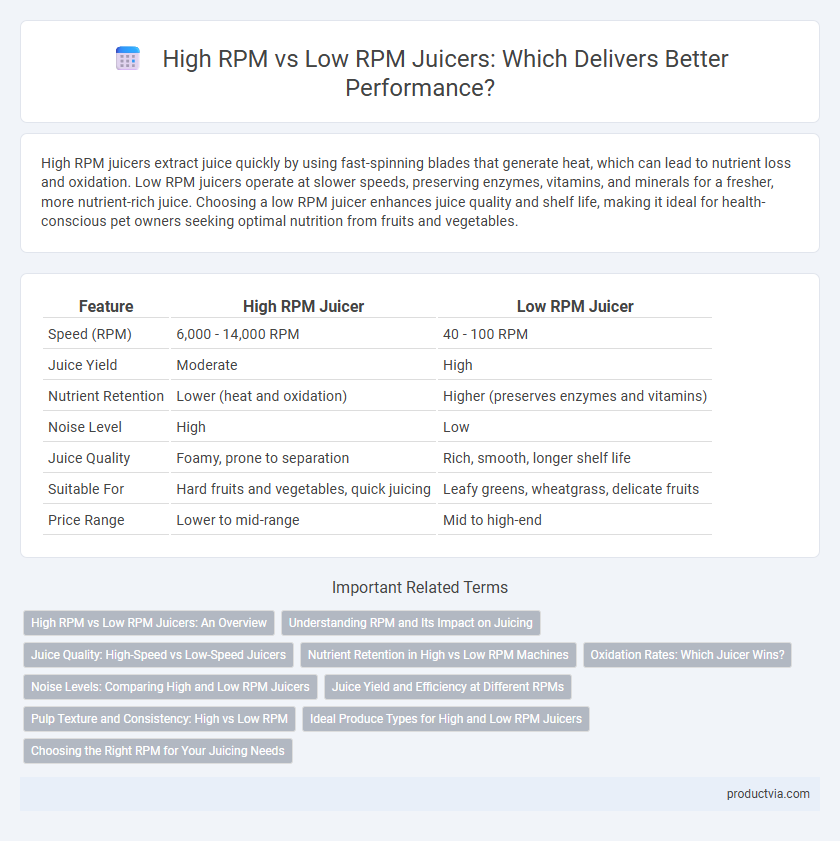High RPM juicers extract juice quickly by using fast-spinning blades that generate heat, which can lead to nutrient loss and oxidation. Low RPM juicers operate at slower speeds, preserving enzymes, vitamins, and minerals for a fresher, more nutrient-rich juice. Choosing a low RPM juicer enhances juice quality and shelf life, making it ideal for health-conscious pet owners seeking optimal nutrition from fruits and vegetables.
Table of Comparison
| Feature | High RPM Juicer | Low RPM Juicer |
|---|---|---|
| Speed (RPM) | 6,000 - 14,000 RPM | 40 - 100 RPM |
| Juice Yield | Moderate | High |
| Nutrient Retention | Lower (heat and oxidation) | Higher (preserves enzymes and vitamins) |
| Noise Level | High | Low |
| Juice Quality | Foamy, prone to separation | Rich, smooth, longer shelf life |
| Suitable For | Hard fruits and vegetables, quick juicing | Leafy greens, wheatgrass, delicate fruits |
| Price Range | Lower to mid-range | Mid to high-end |
High RPM vs Low RPM Juicers: An Overview
High RPM juicers operate at speeds typically above 10,000 revolutions per minute, enabling faster juice extraction but generating more heat and oxidation, which can degrade nutrient quality. Low RPM juicers, also known as masticating juicers, spin at speeds below 100 RPM, preserving enzyme activity and nutrients by minimizing heat and oxidation during slow, thorough pressing. Choosing between high RPM and low RPM juicers depends on balancing speed and juice quality, with low RPM models favored for nutrient retention and high RPM models valued for quick juicing.
Understanding RPM and Its Impact on Juicing
RPM (revolutions per minute) measures how fast a juicer's blade spins, directly impacting extraction efficiency and juice quality. High RPM juicers, typically above 10,000, produce juice quickly but can generate heat that may degrade nutrients and enzymes. Low RPM juicers, often called slow or masticating juicers with speeds around 40-80 RPM, preserve more nutrients by minimizing heat and oxidation during the juicing process.
Juice Quality: High-Speed vs Low-Speed Juicers
High-speed juicers operate at RPMs ranging from 6,000 to 14,000, producing juice quickly but generating heat that may reduce nutrient retention and increase oxidation. Low-speed juicers, often called masticating juicers, run between 40 to 100 RPM, preserving more vitamins, enzymes, and antioxidants by minimizing heat buildup and oxidation during extraction. The choice between high RPM and low RPM juicers significantly impacts juice quality, with low-speed models favored for nutrient-rich, fresh-tasting juice and high-speed models prioritizing speed and convenience.
Nutrient Retention in High vs Low RPM Machines
Low RPM juicers, also known as masticating juicers, operate at slower speeds around 40-80 RPM, preserving more nutrients and enzymes by minimizing heat generation and oxidation during extraction. High RPM juicers, or centrifugal juicers, spin at speeds up to 10,000 RPM, resulting in faster juice extraction but increased heat and oxidation that can degrade sensitive nutrients and reduce overall juice quality. Selecting a low RPM juicer is preferable for maximum nutrient retention, especially for leafy greens and delicate fruits rich in antioxidants and vitamins.
Oxidation Rates: Which Juicer Wins?
High RPM juicers tend to produce more heat and introduce excess oxygen, accelerating oxidation rates and reducing nutrient retention in juices. Low RPM, or cold press juicers, minimize heat and oxygen exposure, preserving enzymes and antioxidants for longer-lasting freshness. Therefore, low RPM juicers outperform high RPM models in maintaining juice quality by effectively reducing oxidation.
Noise Levels: Comparing High and Low RPM Juicers
High RPM juicers typically produce more noise due to faster motor speeds, reaching levels around 80-90 decibels, which can be disruptive in quiet environments. Low RPM juicers operate at slower speeds, often below 60 decibels, making them significantly quieter and more suitable for early morning or office use. Choosing between high and low RPM juicers depends on the balance between noise tolerance and juice extraction speed.
Juice Yield and Efficiency at Different RPMs
High RPM juicers rapidly extract juice by spinning blades at speeds over 10,000 RPM, which increases juice yield but can introduce heat, potentially degrading nutrients and enzymes. Low RPM juicers, operating typically between 40 to 120 RPM, use slow crushing and pressing methods that maximize nutrient retention and minimize oxidation while maintaining efficient juice extraction. Comparing yields, low RPM juicers often produce slightly less juice than high RPM models but deliver higher quality, nutrient-dense juice with better shelf life and efficiency in preserving vitamins.
Pulp Texture and Consistency: High vs Low RPM
High RPM juicers produce finer pulp with a drier consistency, extracting maximum juice by rapidly breaking down fruits and vegetables. Low RPM juicers generate coarser, wetter pulp due to slower, gentler crushing that preserves fiber texture and nutrients. For smoother juice with minimal residue, high-speed juicers excel, while slow masticating juicers offer richer pulp and thicker consistency ideal for nutrient retention.
Ideal Produce Types for High and Low RPM Juicers
High RPM juicers excel at quickly processing soft fruits like berries, grapes, and citrus, maximizing juice yield with minimal foam. Low RPM juicers, often masticating types, are ideal for hard vegetables such as carrots, beets, and leafy greens, preserving nutrients through slow, cold-press extraction. Selecting the appropriate RPM ensures optimal juice quality and efficiency based on the produce's texture and fiber content.
Choosing the Right RPM for Your Juicing Needs
High RPM juicers operate between 6,000 to 14,000 revolutions per minute, efficiently extracting juice quickly but generating heat that may reduce nutrient retention and enzyme activity. Low RPM juicers, spinning at 40 to 80 RPM, preserve more vitamins, antioxidants, and enzymes by minimizing oxidation and heat buildup, ideal for nutrient-dense cold-pressed juices. Selecting the right RPM depends on your priorities: high RPM juicers offer speed and convenience, while low RPM models provide superior juice quality and longevity.
High RPM vs Low RPM for juicer performance Infographic

 productvia.com
productvia.com